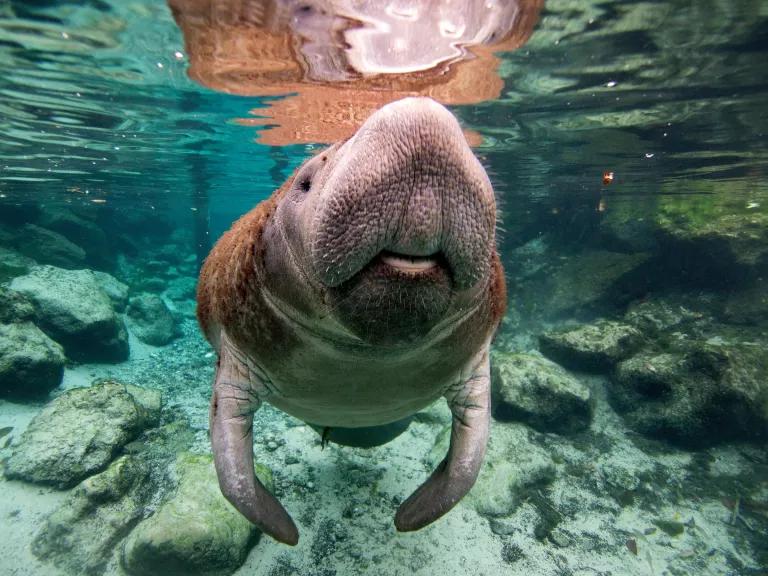Pro-extinction Policies Do Not Sit Well With Americans, Whatever Their Stripe
Four out of five of us express support for the Endangered Species Act. Its attackers should take note.

Bald eagles, the United States’ national symbol.
For years, a small but dogged faction of American lawmakers—almost all of them in the thrall of corporations, land developers, and property-rights zealots—have desperately wanted to gut the Endangered Species Act. The only thing standing in their way: the expressed will of their constituents.
Here’s their conundrum: Some laws passed by Congress are unpopular with relatively large swaths of the American people. The Endangered Species Act (ESA)—signed by President Richard Nixon in 1973 and crafted by lawmakers at his behest—is not one of them. Polls have shown that Americans of all ideological stripes support the law, whose stated purpose is “to protect and recover imperiled species and the ecosystems upon which they depend.”
But now, President Trump’s Interior Department is providing all those anti-ESA lawmakers executive-branch cover for their politically unpalatable cause. Late last week, the department proposed drastic changes to the 45-year-old law, which conservationists, biologists, and wildlife managers almost unanimously credit with saving from extinction many of our country’s most iconic species, including the grizzly bear, the gray wolf, and our national symbol, the bald eagle. These changes might financially benefit the aforementioned special interests, but the consequences for imperiled wildlife would be disastrous—and in many cases, final.
The department’s proposals would significantly disrupt the federal government’s current protection of “threatened” species, the designation that falls just below “endangered.” Currently, both categories are handled similarly. After all, a threatened species today can easily become an endangered one tomorrow. But under the new rules, Interior officials would determine the level of protections that threatened plants and animals receive on a case-by-case basis—meaning that habitat for already struggling species could nevertheless be opened up to land developers, oil and gas drillers, and others whose activities would push the species that much closer to the brink.

Lest you question the plausibility of this scenario, take note of the Trump administration’s other big moves against the ESA. The act stipulates that economic factors shouldn’t influence the decision to save a species from extinction. The new rules would do away with this stipulation. And to add grave insult to grave injury, the department is proposing that its officials no longer be required to consult with scientists and wildlife experts before letting drillers, loggers, or whomever invade (and quite possibly destroy) critical wildlife habitat.
Taken together, these changes amount to a callous new policy, glibly generalized by Slate’s science editor Susan Matthews: “Threatened species no longer get protection, and when they are weak enough to be endangered, we can basically decide not to save them if it’s too expensive.”
The dark satire of a sentence like that one is likely lost on those lawmakers who’ve been waiting for this moment to officially turn a blind eye to the plights of the rufa red knot, the Atlantic sturgeon, and the humble Yosemite toad; to their ears, it must sound like a long-dreamed-of promise, finally and gloriously fulfilled. But even if they aren’t listening to the objections raised by science writers, environmental advocates, and wildlife experts, they are listening, presumably, to voters. And from their constituents—even those who agree with them on most other issues—they’re likely to hear something that sounds a lot like resistance.
On the same day that the Trump administration announced its attacks on the ESA, a new study was published in the journal Conservation Letters showing just how much the public hates this whole idea. The research reflects broad support for protecting endangered species across lines of party, ideology, profession, region, and culture. Among its conclusions is the finding that roughly four out of five Americans support the ESA, with only one in ten saying that they oppose it. Interestingly, 74 percent of self-described conservatives and 77 percent of self-described moderates were in the “supportive” group. (Fully 90 percent of self-described liberals said they supported the act.)

Furthermore, the way Americans feel about the ESA has remained at or near these high levels for the past 20 years. The data show that support for the law has not wavered even as efforts to weaken it have ramped up—a sign that the arguments for gutting it aren’t gaining traction.
Nor will they. That’s because most Americans understand why the Endangered Species Act is there in the first place, especially during an era when climate change is threatening so many species all over the planet. We can argue among ourselves about what does or doesn’t make America great. But we all seem to agree that to lose any species forever makes us lesser, in a real, poignant, and shameful way.
This article was originally published on onEarth, which is no longer in publication. onEarth was founded in 1979 as the Amicus Journal, an independent magazine of thought and opinion on the environment. All opinions expressed are those of the authors and do not necessarily reflect the policies or positions of NRDC. This article is available for online republication by news media outlets or nonprofits under these conditions: The writer(s) must be credited with a byline; you must note prominently that the article was originally published by NRDC.org and link to the original; the article cannot be edited (beyond simple things such grammar); you can’t resell the article in any form or grant republishing rights to other outlets; you can’t republish our material wholesale or automatically—you need to select articles individually; you can’t republish the photos or graphics on our site without specific permission; you should drop us a note to let us know when you’ve used one of our articles.


How to Make an Effective Public Comment
From Dams to DAPL, the Army Corps’ Culture of Disdain for Indigenous Communities Must End
A Trailblazer for Tribal Sovereignty